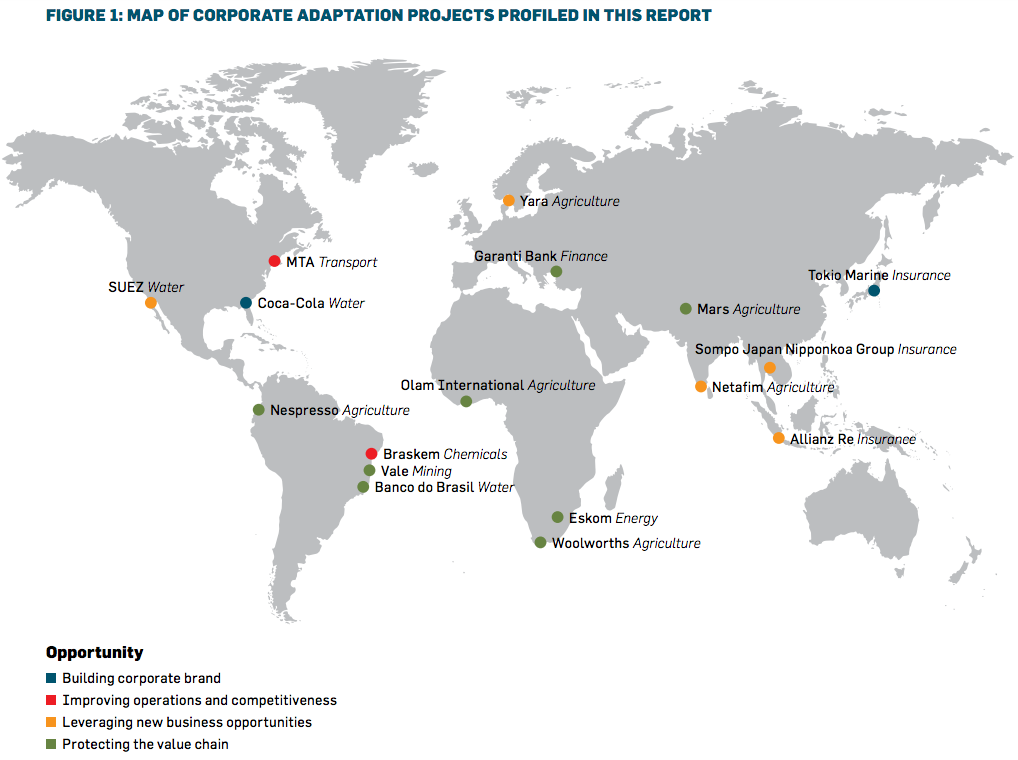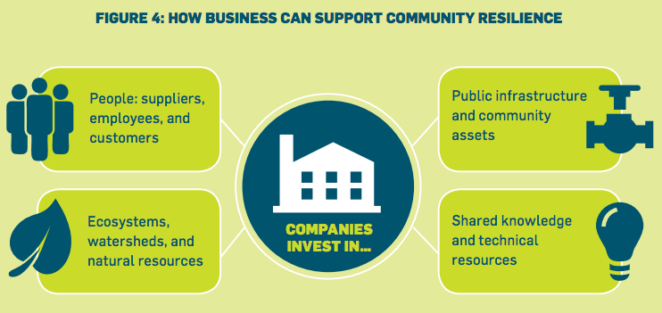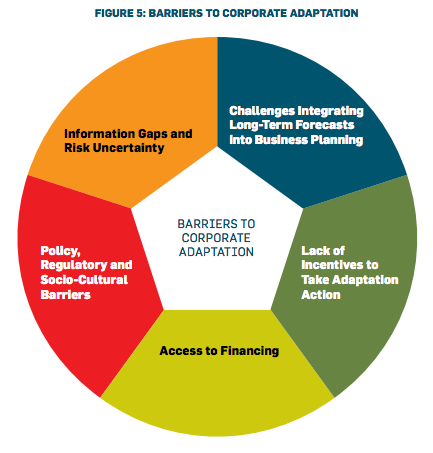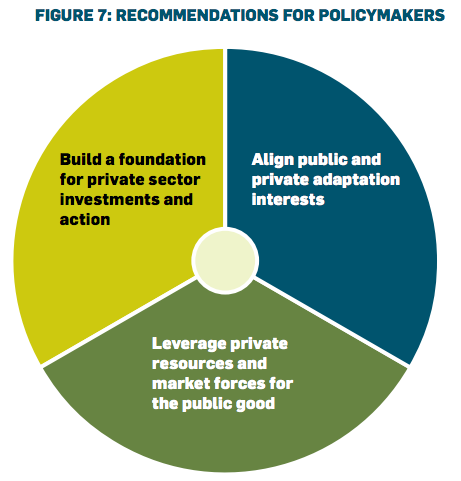The Business Case for Responsible Corporate Adaptation: Strengthening Private Sector and Community Resilience

Foreword
The private sector plays a key role in reducing global greenhouse gas emissions and has made significant progress in mitigating its carbon footprint. While corporate measures to prepare and adapt to climate change impacts are just as critical, they are not yet as widespread.
Responsible corporate adaptation encompasses the strategies, actions and partnerships through which businesses adapt to climate impacts and at the same time create shared resilience benefits for the communities and ecosystems where they operate. Climate change impacts will be felt disproportionately in communities that lack the resources and infrastructure to effectively prepare for and adjust to these impacts. When companies take action to support and empower the communities they depend on, they will also reap the benefits.
This report* is an invitation for companies to become leaders in advancing social, environmental and economic resilience through responsible corporate adaptation. Developed by Caring for Climate – a joint initiative of the UN Global Compact, UNEP and UNFCCC secretariat – together with partners, this report shares lessons learned and provides actionable guidance for both public and private sector leaders. It highlights how companies can adapt to climate change, and how to address the most pressing challenges that stymie private sector progress.
The report’s recommendations will be useful to businesses as they actively engage in advancing the Sustainable Development Goals (SDGs), adopted by the United Nations General Assembly in September 2015 with the aim of eliminating poverty, overcoming inequality and addressing environmental degradation across the globe. The SDGs are an example of ambitious targets arrived at through inclusive multi-stakeholder engagement and broad consensus. They will play a key role in shaping local adaptation activities to meet global climate goals.
The Recommendations for Policymakers section and the Contents of the report are provided below.
*Downloadfrom the right-hand column or via links below.
Recommendations for Policymakers
Build a Foundation for Private Sector Investments and Action
Creating an enabling environment is fundamental to private sector adaptation. Governments that understand and communicate the business case for corporate adaptation and can identify clear roles and responsibilities for the private sector in national adaptation planning and implementation will be able to better leverage private sector resources. Key to making this case is the ability to provide businesses with the information and tools they need to make investments that support climate resilience in vulnerable communities. Local officials can highlight risks to public infrastructure that local business operations depend on to incentivize crosssector collaboration to develop solutions. Policymakers should keep in mind variances in decision-making processes for businesses (e.g., much shorter planning time horizons) and work to identify common, near-term risks from climate impacts as well as concrete actions to mitigate those risks.
Recommended Activities:
- Generate and provide local risk and climate change impact information, including cost-benefit analysis, in a format and at a scale that relevant stakeholders, including companies, can use to inform their adaptation analysis and actions.
- Develop common language and reference concepts: using a shared terminology helps identify opportunities for partnerships and common interests between different stakeholders. Include concepts that adequately reflect how companies are approaching adaptation (e.g., many companies will not distinguish between adaptation activities and initiatives to improve energy efficiency or address resource scarcity).
- Mainstream climate change considerations into planning processes and regulations, e.g., building and infrastructure standards to increase resilience.
- Communicate about resilience efforts and adaptation plans to help inform and attract investors.
Align Public and Private Adaptation Interests
Governments should encourage the replication of leading practices to build climate resilience by disseminating successful examples of responsible corporate adaptation activities in their communities. Specifically, local officials should assess community vulnerabilities and needs and outline roles that local businesses could play in addressing these issues while advancing their own corporate adaptation strategies. This type of locally focused gap analysis should discourage maladaptive efforts and prevent private companies from contributing to increased vulnerability through precautionary measures that secure scarce resources for themselves.
Recommended Activities:
- Identify and address policies, codes and regulations that create barriers or inhibit private sector action to build resilience.
- Ensure agencies leading the public adaptation planning process are equipped with the necessary resources to actively engage business stakeholders and leverage private sector expertise.
- Involve private sector stakeholders in the development of adaptation strategies and plans to address pressing climate change adaptation priorities, such as water security, agriculture and disaster risk reduction.
- Develop policy and regulatory frameworks to guide responsible corporate adaptation practices, and work with local business associations to promote systematic information sharing.
Leverage Private Resources and Market Forces for the Public Good
Governments that can demonstrate longterm policy and finance commitments to adaptation through legislation, support for adaptation planning processes and the creation of appropriate institutions will send clear market signals that help to reduce uncertainty and to incentivize both investment and engagement by the private sector. The 2011 Caring for Climate report on adaptation stated that, “the quality of the overall investment environment will also affect adaptation”. Governments can draw upon private sector organizations already engaged with adaptation to create new channels for private sector participation, thus encouraging responsible corporate engagement in climate policy at the national level.
Recommended Activities:
- Develop incentives and opportunities for private sector stakeholders to “match” public funds for mutually beneficial adaptation initiatives.
- Develop strategies for leveraging and mobilizing private sector expertise and resources in building climate resilience and develop sector-specific solutions.
- Stimulate the market for adaptation through financial and risk reduction incentives and address market failures in building climate resilience.
- Consider providing financial incentives and opportunities to stimulate the uptake of climate-resilient technologies and services, such as subsidies for sustainable agricultural equipment, resilient design competitions, micro-insurance for smallholder farmers, co-financing for research and development of new products and services or preferential tariffs for sustainablysourced products.

Report contents
This comprehensive report contains the following sections and sub-sections:
Introduction: A New Paradigm for Corporate Climate Action
- Climate Change is a Business Risk
- Climate Change Brings New Opportunities
- Responsible Corporate Adaptation in Practice
Chapter 1: The Business Benefits of Adapting Responsibly to Climate Change
- What is Responsible Corporate Adaptation?
- The Benefits of Responsible Corporate Adaptation
- Improving Operations and Competitiveness
- Protecting the Value Chain
- Leveraging New Business Opportunities
- Building Corporate Brand
Chapter 2: Overcoming Barriers to Corporate Adaptation Information Gaps and Risk Uncertainty
- Challenges Integrating Long-Term Forecasts into Business Planning
- Lack of Incentives to Take Adaptation Action
- Access to Financing
- Policy, Regulatory and Socio-Cultural Barriers

Chapter 3: Case Studies – Responsible Corporate Adaptation in Practice
- Overview of Case Studies
- Allianz Re: Increasing Food Security in Asia through Satellite-Based Information and Insurance
- Banco do Brasil: Financing Sustainable Agriculture for Sustainable Local Economies
- Braskem: Industrial Water Reuse as Part of the Business Climate Strategy: A Financial and Social Win-Win
- Coca-Cola: Global Water Stewardship and Conservation
- Eskom: Integrated Risk and Resilience Management Procedure for Climate Change Adaptation Planning
- Garanti Bank: Climate-Sensitive Business Policies to Mitigate Water Risk and Ensure Financial Performance
- Mars: Sustainable Rice Farming in Pakistan
- Metropolitan Transportation Authority (MTA): Responding to Hurricane Sandy
- Nespresso: Resilient Landscapes for Sustainable Farming and Livelihoods
- Netafim: Advancing Drip Irrigation Practices in Rice Production in India
- Olam: Supporting Ghanaian Farmers with the World’s First Climate-Smart Cocoa
- Sompo Japan Nipponkoa Group: Weather Index Insurance to Enhance Resilience of Agriculture in Developing Countries
- SUEZ: Circular Water Economy – Beyond Adaptation, a Way to Secure and Renew Water Resources
- Tokio Marine: Protecting Natural Resources and Building Local Resilience to Natural Disasters
- Vale: Nowcasting System for Harbor Operations in Brazil
- Woolworths: Improving the Climate Resilience of South African Fruit and Vegetable Farmers
- Yara: Tackling Food Security, Water Scarcity and Climate Change
Chapter 4: Accelerating Responsible Corporate Adaptation – Recommendations for Business Leaders and Policymakers
- Recommendations for Business Leaders
- Identify Critical Climate Risks and Uncover Opportunities
- Determine your Company’s Climate Adaptation Strategy
- Develop Strategic Partnerships Focused on Shared Value Creation
- Report on Progress and Increase Transparency
- Recommendations for Policymakers
- Build a Foundation for Private Sector Investments and Action
- Align Public and Private Adaptation Interests
- Leverage Private Resources and Market Forces for the Public Good

Annexes
- What Companies Reported in 2015 on Climate Risk and Opportunities
- Disaster Risk Management and Safe-Guarding Investments and Operations
Information Boxes
- How Were the Case Studies in This Publication Selected?
- The Economic Cost of Climate Change
- The Sustainable Development Goals (SDGs) and the 2030 Agenda for Sustainable Development
- Climate Change Adaptation Under the UN Framework Convention on Climate Change – How Business Can Engage
- Preventing Maladaptation
- Emerging Solutions to Drive Private Investment in Climate Resilience
- Conducting a Climate Risk Assessment – Tools of the Trade
- Climate Adaptation and the Specific Challenges of SMEs
This is a Caring for Climate Report by the United Nations Global Compact (UN Global Compact), the secretariat of the United Nations Framework Convention on Climate Change (UNFCCC) and the United Nations Environment Programme (UNEP), in cooperation with UNEP DTU Partnership, CDP, CEO Water Mandate, Four Twenty Seven, Oxfam, Rainforest Alliance, ARISE (through PwC), University of Notre Dame (ND-GAIN) and World Resources Institute (WRI).
- Project Manager: Bernhard Frey
- Lead Consultant: Emilie Mazzacurati
- Designer: Hedie Assadi Joulaee
(0) Comments
There is no content